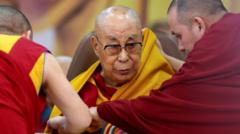The process will bring together 133 cardinals in a charged atmosphere, as whispers of alliances and rivalries fill the air while they seek a new leader.
**The Intrigue of Papal Selection: Inside the Conclave**

**The Intrigue of Papal Selection: Inside the Conclave**
As the Vatican braces for the conclave, the race to choose the next pope witnesses both competition and secrecy.
The Sistine Chapel is set to become the focus of the Catholic world starting Wednesday, as the conclave convenes to select a successor to Pope Francis, who passed away at the age of 88 last month. A total of 133 cardinals from across the globe will gather in this historic setting, renowned for its stunning Michelangelo frescoes, to cast their votes in a process steeped in tradition and intrigue.
Jason Horowitz, the New York Times’ Rome bureau chief and seasoned observer of papal elections, describes the conclave as brimming with “pure politics, backstabbing, and occasionally throwing people under the bus.” He has covered previous conclaves in 2005 and 2013, emphasizing the dramatic behind-the-scenes maneuvering that characterizes these selections.
During the conclave, the cardinals will hold secret ballot votes as many as four times a day. Following each round, the smoke emitted from a chimney atop the chapel will serve as a signal to the world, with black smoke indicating no consensus and white smoke revealing the election of a new pope. The selection process has been known to end as quickly as a few hours, but could extend to years, with the longest recorded conclave lasting nearly three years.
Once the white smoke rises, audiences will eagerly await news of the newly elected pontiff, which the New York Times pledges to deliver promptly, alongside insights into his ecclesiastical perspectives. However, Horowitz notes the ever-present possibility of a “dark-horse candidate” who could swoop in unexpectedly to claim the papacy.
Jason Horowitz, the New York Times’ Rome bureau chief and seasoned observer of papal elections, describes the conclave as brimming with “pure politics, backstabbing, and occasionally throwing people under the bus.” He has covered previous conclaves in 2005 and 2013, emphasizing the dramatic behind-the-scenes maneuvering that characterizes these selections.
During the conclave, the cardinals will hold secret ballot votes as many as four times a day. Following each round, the smoke emitted from a chimney atop the chapel will serve as a signal to the world, with black smoke indicating no consensus and white smoke revealing the election of a new pope. The selection process has been known to end as quickly as a few hours, but could extend to years, with the longest recorded conclave lasting nearly three years.
Once the white smoke rises, audiences will eagerly await news of the newly elected pontiff, which the New York Times pledges to deliver promptly, alongside insights into his ecclesiastical perspectives. However, Horowitz notes the ever-present possibility of a “dark-horse candidate” who could swoop in unexpectedly to claim the papacy.





















